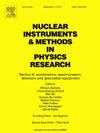Evaluation of cosmogenic Ge-68 background in a high purity germanium detector via a time series fitting method
IF 1.5
3区 物理与天体物理
Q3 INSTRUMENTS & INSTRUMENTATION
Nuclear Instruments & Methods in Physics Research Section A-accelerators Spectrometers Detectors and Associated Equipment
Pub Date : 2025-04-04
DOI:10.1016/j.nima.2025.170472
引用次数: 0
Abstract
Ge-68 is a cosmogenic isotope in germanium with a half-life of 270.9 days. Ge-68 and its decay daughter Ga-68 contribute considerable background with energy up to 3 MeV to low background spectrometers using high purity germanium (HPGe) detectors. In this paper, we evaluated the background of Ge-68 and Ga-68 in a -type coaxial HPGe detector operated at China Jinping underground laboratory (CJPL) via a time series fitting method. Under the assumption that Ge-68 and Ga-68 are in radioactive equilibrium and airborne radon daughters are uniformly distributed in the measurement chamber of the spectrometer, we fit the time series of count rate in 1-3 MeV to calculate the Ge-68 activity, radon daughter concentrations, and the time-invariant background component. A total of 90-day measurement data were used in the analysis, a hypothesis test confirmed a significant Ge-68 signal at 99.64% confidence level. The initial activity of Ge-68 is fitted to be 477.0Bq/kg, corresponding to an integral count rate of 55.9 count/day in the 1-3 MeV range. During the measurement, Ge-68 activity decreased by about 30%, contributing about 62% of the total background in the 1-3 MeV range. Our method also provides an estimation of the variation of airborne radon daughter concentrations in the measurement chamber, which could be used to monitor the performance of radon reduction measures.
用时间序列拟合方法评价高纯锗探测器的宇宙成因Ge-68背景
锗-68是锗中的一种宇宙成因同位素,半衰期为270.9天。Ge-68及其衰变子Ga-68为使用高纯锗(HPGe)探测器的低背景γ光谱仪贡献了可观的能量高达3 MeV。假设Ge-68和Ga-68处于放射性平衡状态,气载氡子体均匀分布在光谱仪的测量室内,拟合1-3 MeV计数率的时间序列,计算Ge-68的活度、氡子体浓度和时不变背景分量。采用90天的测量数据进行分析,假设检验证实Ge-68信号在99.64%的置信水平上显著。在1-3 MeV范围内,Ge-68的初始活性为477.0±112.4μBq/kg,对应的积分计数率为55.9计数/天。在测量期间,Ge-68的活度下降了约30%,约占1-3 MeV范围内总背景的62%。我们的方法还提供了测量室内空气氡子浓度变化的估计,可用于监测氡还原措施的效果。
本文章由计算机程序翻译,如有差异,请以英文原文为准。
求助全文
约1分钟内获得全文
求助全文
来源期刊
CiteScore
3.20
自引率
21.40%
发文量
787
审稿时长
1 months
期刊介绍:
Section A of Nuclear Instruments and Methods in Physics Research publishes papers on design, manufacturing and performance of scientific instruments with an emphasis on large scale facilities. This includes the development of particle accelerators, ion sources, beam transport systems and target arrangements as well as the use of secondary phenomena such as synchrotron radiation and free electron lasers. It also includes all types of instrumentation for the detection and spectrometry of radiations from high energy processes and nuclear decays, as well as instrumentation for experiments at nuclear reactors. Specialized electronics for nuclear and other types of spectrometry as well as computerization of measurements and control systems in this area also find their place in the A section.
Theoretical as well as experimental papers are accepted.

 求助内容:
求助内容: 应助结果提醒方式:
应助结果提醒方式:


